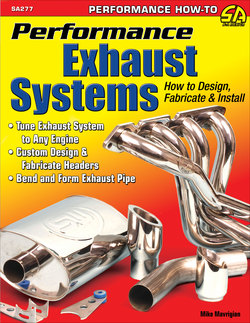Читать книгу Performance Exhaust Systems: How to Design, Fabricate, and Install - Mike Mavrigian - Страница 6
На сайте Литреса книга снята с продажи.
ОглавлениеINTRODUCTION
The exhaust system is a vital component of engine package, but all too often exhaust system design, components, and function are an afterthought. Owners arbitrarily bolt on a header, resonator, catalytic converter, and muffler combination that may or may not be suited to the chassis or properly tuned to deliver the best performance. When building a high-performance engine application, you need to consider the function and operation as an integrated system. In particular, the carb, intake, and cam directly dictate how much fuel is put into the engine. Moreover, the air/fuel mixture that is put into the engine must be evacuated from the engine. The engine needs to evacuate exhaust gas from the combustion chamber efficiently and quickly. However, it also effectively scavenges and returns unburned to the combustion chamber during the scavenging process. An exhaust system that’s ill suited to the engine degrades performance pure and simple.
The book is your hands-on guide to achieve the ultimate in exhaust performance. It’s not a guide that provides advanced physics and flow dynamics to explain theory and function of exhaust. Instead, it provides practical advice and easy-to-understand math so you gather all the right components for your engine. It allows you to understand your engine’s exhaust system and select exhaust system components, with regard to function and engine performance as well as appearance. The discussions include exhaust header design and sizing, exhaust pipe sizing, exhaust pipe crossovers, bending, flanges, clamping and hanging, muffler designs, catalytic converter design, troubleshooting and break-in, exhaust component materials and specialty coatings, exhaust system math, exhaust design and sizing for turbocharging and supercharging, cylinder head exhaust valves and port design, the intake system that affects exhaust output, camshaft design that affects the exhaust pulse, and more.
Complete engine-to-tip systems are available for most popular vehicle applications.
Choosing an aftermarket performance exhaust system, or individual system components, such as headers or mufflers, can be a daunting task because of the wide range of offerings. This book makes the process of selecting individual components or a complete system much easier. Whether you’re assembling an exhaust system using off the off-the-shelf components or designing an exhaust system for special applications, the goal of this book is to guide you from planning stage to final installation so you have a properly designed, well tuned, and safe exhaust system.
Specifically, this book delivers insight regarding how exhaust headers, pipes, and mufflers are designed and manufactured, how various engine components affect the exhaust stream, and tips on selecting system pieces as well as various installation tips. It provides a thorough explanation of engine design, function, airflow, and of course exhaust flow.
I delve into the principles of exhaust gas flow so you understand the function and purpose of each component and can apply them to your particular project. I also discuss each component in the exhaust system, its function, and how it relates to other components in the system. I show you down-to-earth math so you can determine the ideal exhaust system and components for your particular application. Keep in mind that all components are interrelated and to achieve max performance all the components need to be compatible and complementary.
I show you how to plan, fit, bend, and fabricate pipes to fit a particular engine and chassis combination. Exhaust gases are routed into the headers as they immediately leave the engine, and header design, tube length, and tube diameter have an immense impact on performance. Resonators, catalytic converters, and mufflers are all part of the high-performance exhaust equation, and I reveal each pertinent aspect of selecting the best exhaust components for your particular system.
Chapter 1 provides a comprehensive overview and explanation of engine components that are involved in intake and exhaust flow, including discussions of intake air, carburetors, EFI throttle bodies, mass airflow sensors, fuel injector sizing, cylinders head design and function, camshaft technology (including explanations of such areas as intake and exhaust valve lift, duration, lobe separation angle, centerline, cam timing), and an explanation of special-firing-order camshafts. Also included in this chapter are discussions of exhaust manifolds, an explanation of engine pumping losses, engine intake, exhaust, compression and power stroke events, and information regarding oxygen sensors.
Chapter 2 focuses on exhaust system components, including exhaust manifolds and tubular headers, exhaust pipe, mufflers, and catalytic converters.
Chapter 3 offers specific information about exhaust pipe sizing and bending, including an understanding of various bending methods such as crush bending, wrinkle bending, and mandrel bending, as well as various bending methods such as CNC and machine-assisted manual bending. This chapter also includes a discussion of dual-exhaust system crossovers, exhaust pipe support hangers, and pipe connections, as well as helpful information regarding conversions from a single- to a dual-exhaust system.
Chapter 4 contains detailed information that reveals the correct system and exhaust header type for your engine. This includes primary tube sizing and length, tubing materials and bending, port matching and exhaust header scavenging, the use and advantages of specialty exhaust header coatings, and more.
Chapter 5 delves into the muffler and catalytic converters that are suitable for particular systems and applications. In this chapter I examine specific technology, materials, and intended muffler and catalytic converter application.
Chapter 6 covers exhaust system design and applications specifically for forced-induction applications such as turbocharging and supercharging.
Chapter 7 offers a variety of relative mathematical formulas so you can determine the correct design, size, and components of your exhaust system.
At the end of the book, a Source Guide lists selected manufacturers of automotive performance exhaust systems and components.
